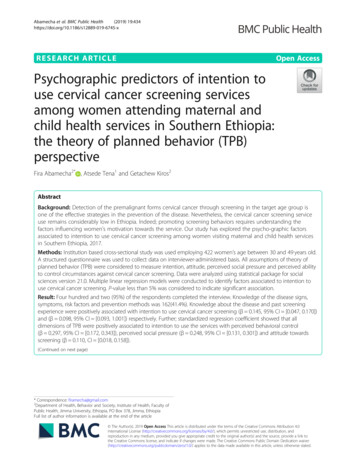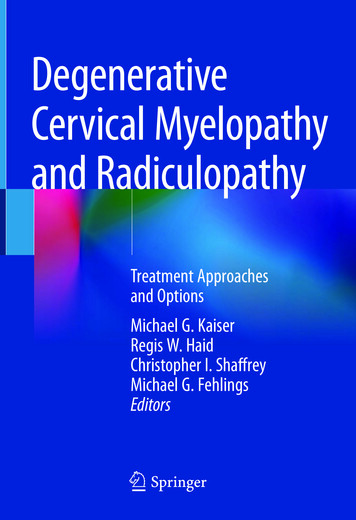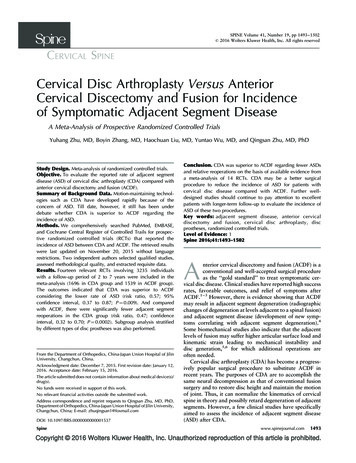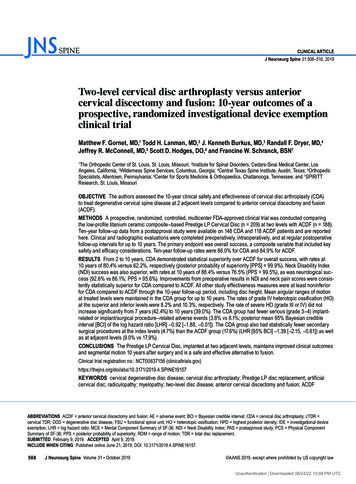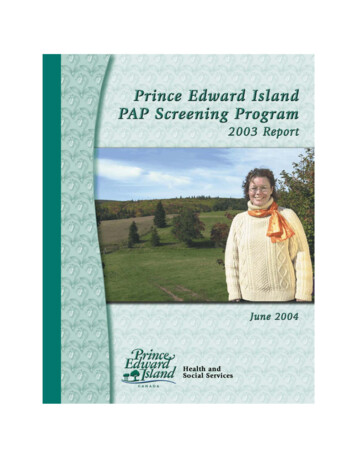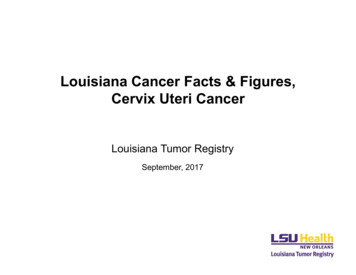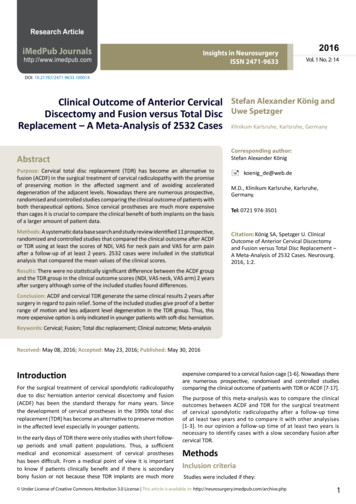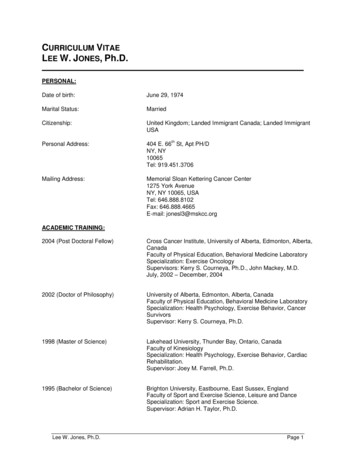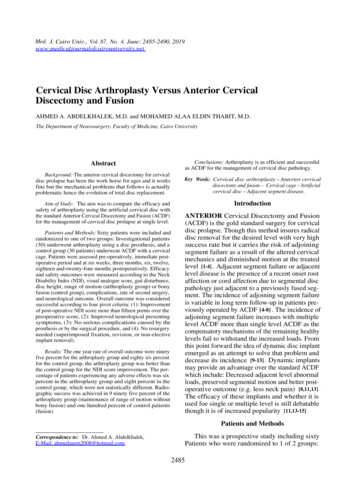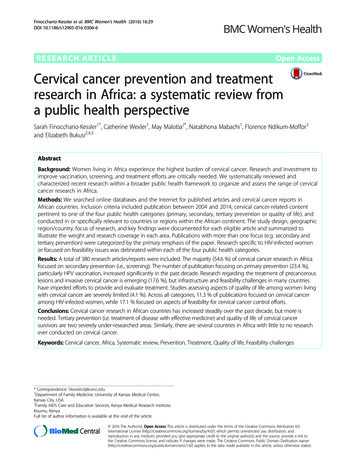
Transcription
Finocchario-Kessler et al. BMC Women's Health (2016) 16:29DOI 10.1186/s12905-016-0306-6RESEARCH ARTICLEOpen AccessCervical cancer prevention and treatmentresearch in Africa: a systematic review froma public health perspectiveSarah Finocchario-Kessler1*, Catherine Wexler1, May Maloba2*, Natabhona Mabachi1, Florence Ndikum-Moffor3and Elizabeth Bukusi2,4,5AbstractBackground: Women living in Africa experience the highest burden of cervical cancer. Research and investment toimprove vaccination, screening, and treatment efforts are critically needed. We systematically reviewed andcharacterized recent research within a broader public health framework to organize and assess the range of cervicalcancer research in Africa.Methods: We searched online databases and the Internet for published articles and cervical cancer reports inAfrican countries. Inclusion criteria included publication between 2004 and 2014, cervical cancer-related contentpertinent to one of the four public health categories (primary, secondary, tertiary prevention or quality of life), andconducted in or specifically relevant to countries or regions within the African continent. The study design, geographicregion/country, focus of research, and key findings were documented for each eligible article and summarized toillustrate the weight and research coverage in each area. Publications with more than one focus (e.g. secondary andtertiary prevention) were categorized by the primary emphasis of the paper. Research specific to HIV-infected womenor focused on feasibility issues was delineated within each of the four public health categories.Results: A total of 380 research articles/reports were included. The majority (54.6 %) of cervical cancer research in Africafocused on secondary prevention (i.e., screening). The number of publication focusing on primary prevention (23.4 %),particularly HPV vaccination, increased significantly in the past decade. Research regarding the treatment of precancerouslesions and invasive cervical cancer is emerging (17.6 %), but infrastructure and feasibility challenges in many countrieshave impeded efforts to provide and evaluate treatment. Studies assessing aspects of quality of life among women livingwith cervical cancer are severely limited (4.1 %). Across all categories, 11.3 % of publications focused on cervical canceramong HIV-infected women, while 17.1 % focused on aspects of feasibility for cervical cancer control efforts.Conclusions: Cervical cancer research in African countries has increased steadily over the past decade, but more isneeded. Tertiary prevention (i.e. treatment of disease with effective medicine) and quality of life of cervical cancersurvivors are two severely under-researched areas. Similarly, there are several countries in Africa with little to no researchever conducted on cervical cancer.Keywords: Cervical cancer, Africa, Systematic review, Prevention, Treatment, Quality of life, Feasibility challenges* Correspondence: Skessler2@kumc.edu1Department of Family Medicine, University of Kansas Medical Center,Kansas City, USA2Family AIDS Care and Education Services, Kenya Medical Research Institute,Kisumu, KenyaFull list of author information is available at the end of the article 2016 The Author(s). Open Access This article is distributed under the terms of the Creative Commons Attribution 4.0International License (http://creativecommons.org/licenses/by/4.0/), which permits unrestricted use, distribution, andreproduction in any medium, provided you give appropriate credit to the original author(s) and the source, provide a link tothe Creative Commons license, and indicate if changes were made. The Creative Commons Public Domain Dedication o/1.0/) applies to the data made available in this article, unless otherwise stated.
Finocchario-Kessler et al. BMC Women's Health (2016) 16:29BackgroundCervical cancer is the second most common cancer amongwomen worldwide, with an estimated 528,000 new casesand 266,000 deaths among women each year [1]. A disproportionate number of these cases (85 %) and deaths (87 %)occur among women living in low and middle incomecountries [1]. Women living with HIV are at increased riskof developing cervical cancer [2–4] and experience morerapid progression of the disease [5–7]. Since 1993, cervicalcancer was classified as an AIDS-defining illness [8].The World Health Organization (WHO) advocates acomprehensive approach to cervical cancer preventionand control to identify opportunities to deliver effectiveinterventions [9]. Cervical cancer-related research hasincreased significantly over the past decade, representingbiomedical, behavioral, and policy level findings. Existingreview papers synthesize knowledge and advancementsfor multiple areas of focus within the larger effort of cervical cancer prevention and treatment, e.g., biomarkersfor cervical cancer [10, 11], HPV vaccination for youngadolescent women [12–15], and feasible approaches toscreen and treat adult women in low resource settings[16–20]. The purpose of this systematic review is to assess and characterize recent research within a broaderpublic health framework, utilizing well-known publichealth terminology to organize and assess the range ofefforts to respond to cervical cancer. In this context,these include: Primary Prevention (preventing the initialonset of cervical cancer), Secondary Prevention (earlydetection by screening and treatment of precancerous cervical lesions), Tertiary Prevention (treatment of cervicalcancer to reduce morbidity and mortality), and Quality ofLife (post-treatment care or palliative care for those withouttreatment options) among women in African countries.Literature highlighting feasibility considerations (accessibility, affordability, health care infrastructure, and providertraining) and findings specific to HIV-infected women areintegrated as appropriate in each public health category.Primary preventionVaccination is one of the most commonly used publichealth strategies to reduce the risk of infection andminimize the prevalence of the disease-causing agent(HPV) in the environment. Nearly all cases (99.7 %) ofcervical cancer are caused by human papillomavirus(HPV) [21], particularly types 16 and 18 which cause morethan two-thirds of all precancerous cervical lesions andcervical cancers [22, 23]. HPV is one of the most commonsexually transmitted infections, with up to 75 % of sexuallyactive people estimated to be infected at some point during their lives [24]. Fortunately, two vaccines are approvedfor use. The bivalent vaccine protects against HPV types16 and 18. The quadrivalent vaccine protects against HPVtypes 16 and 18 and also types 6 and 11, which cause 90 %Page 2 of 25of genital warts [25]. Since HPV infection often occursshortly after the onset of sexual activity (over 35 % ofwomen are infected within 2 years of initiating sexual activity) [26–28], vaccination campaigns should target 9–13year old youth, prior to sexual debut. The vaccines areover 95 % effective at preventing HPV infection caused byvaccine-type HPV when the full three course dose is givenover six months [29, 30]. Since 2014, the WHO recommends a two-dose regimen for girls and boys aged 9–13(quadrivalent vaccine) or aged 9–14 (bivalent vaccine)[31], which is not yet licensed in all countries, but reducesthe follow-up burden while maintaining strong protectivecoverage [32–35].The WHO recommends the inclusion of HPV vaccination in national immunization programs provided HPVrepresents a public health priority and vaccine delivery isfeasible and cost-effective [31]. Unfortunately, HPV vaccination is not yet available in many African countries. ByAugust 2014, only 58 countries had introduced HPV vaccination for girls into their national immunization program[31]. While the majority of these are high-resourcecountries, a few low to middle income countries in Africaincluding Rwanda, South Africa, Lesotho, and Uganda [36]have also introduced national HPV vaccines. In 2013, theGlobal Alliance for Vaccines and Immunizations (GAVI)began providing support for HPV vaccinations to eligiblecountries and will support demonstration projects in 23countries, of which ten have been launched, primarily insub-Saharan Africa [37, 38]. However, barriers to vaccination (i.e. concerns about the safety of the vaccine, providerreservations about recommending vaccination for youngergirls, limited awareness of the relationship between HPVand cervical cancer, and varied parental acceptance of theHPV vaccine [39–42]) result in inconsistent vaccine uptake,globally [13, 43]. Recent efforts to vaccinate young boyshave received less focus, but may help indirectly protectgirls by reducing the risk of re-infection with HPV and willhelp prevent other HPV-related morbidities for men including penile cancer, anal cancer, oropharyngeal cancer,and genital warts [44].Other primary prevention strategies to reduce HPV infection and cervical cancer include delaying sexual debut,reducing the number of lifetime sexual partners, and increasing condom use [45]. In addition to reducing HIV acquisition and transmission, medical male circumcision isalso protective for HPV in males [46–48], which reducesthe risk of initial or re-infection of HPV among women.Secondary preventionScreening for early detection and treatment is a cornerstone of secondary prevention. Early diagnosis and treatment of cervical pre-cancerous lesions prevents up to80 % of cervical cancers in high resource countrieswhere cervical cancer screening is routine [49]. In higher
Finocchario-Kessler et al. BMC Women's Health (2016) 16:29income countries, cervical cytology (Pap smear) in whichcervical cells are examined in order to detect cervicalintraepithelial neoplasia (CIN) became part of routinecare in the 1940’s [50]. For women who screen positivefor premalignant cervical lesions (i.e., CIN), a confirmatory colposcopy is required [51]. Cervical cytology, however, is not a feasible method of screening in manyAfrican countries given the required level of medical andlaboratory infrastructure and trained personnel, multiplereturn visits with poor patient tracking strategies, andavailability of such services often limited to capital cities.The proportion of women in sub Saharan Africa reportinga pelvic exam and pap test in the previous three years isvery low (1.0 % in Ethiopia to 23.2 % in South Africa), with40 % of women in Tunisia to 94 % of women in Malawihaving never received a pelvic exam [52, 53].The more feasible, and WHO-approved, strategy forcervical cancer screening in low resource settings is visualinspection with acetic acid (VIA) or visual inspection withLugol’s iodine (VILI). After applying acetic acid or Lugol’siodine directly on the cervix, pre-cancerous and cancerouslesions turn white, making them visible to the naked eye[54]. This method has high sensitivity among HIVinfected and uninfected women [55, 56]. Results areimmediate, thus women who screen positive for precancerous lesions can theoretically be offered cryotherapytreatment during the same visit, or a “screen and treat”approach, if the health facility has the capacity. This strategy has been shown cost-effective, affordable, and an idealfirst-line treatment for CIN of any grade when the cervicallesion size and location allows the cryoprobe tip to makeadequate contact [57–60]. This ‘screen and treat’ strategycan avoid the burden of costly follow up visits, significantdelays in treatment, and loss to follow up [61, 62].Cryotherapy can be performed at the primary care levelby mid-level providers, such as nurses or midwives, whocan be trained to perform cryotherapy with a minimum ofsupplies and equipment [58, 63]. In developed countries,cryotherapy is approximately 90 % effective for all gradesof CIN after 1 year [64]. The most commonly employedtreatment options for pre-cancerous lesions are removalof diseased tissue using loop electrosurgical excision procedure (LEEP) which requires local anesthetic [65, 66] orby freezing the affected tissue with cryotherapy [57].These treatments are typically performed by trained providers in outpatient clinics at provincial or referral levelhospitals. Cold-knife conization [65] can be used to remove lesions that cannot be effectively treated with LEEPor cryotherapy.The optimal frequency of screening is every 3–5 yearsdepending on screening method [67], or within 3 yearsfor women living with HIV [68]. If a woman can bescreened only once in her lifetime, the most strategicage is between 30 and 39 years [69]. Recent estimates onPage 3 of 25national rates of cervical cancer screening are not available for many African countries, but a number of studiesreport self-reported screening rates to be low (8.3–64 %)[70–74], but slightly higher among women accessingHIV-care (9.4–80 %) [72, 75, 76]. A 2008 populationbased survey in 57 countries estimated 19 % of womenin developing countries were screened for cervicalcancer in the preceding three years [77]. In addition toinfrastructure and resource-related barriers, awarenessof cervical cancer among reproductive-aged women remains low [70, 78–81] and an inadequate proportion ofhealth care providers has been trained to provide highquality screening [82, 83]. Efforts have been made inmany countries to integrate cervical cancer screening inHIV care, but routine provision is still limited [77, 84].HPV DNA testing represents an emerging strategy forearly detection of cervical cancer, particularly if technology innovations can permit point-of-care testing whichwill eliminate requirements for laboratory infrastructureand technical support [68, 85]. HPV DNA testing must bemade affordable for widespread use in African countries.Tertiary preventionWomen with abnormal cervical tissue are diagnosed witheither precancerous lesions or invasive cervical cancer,both of which require treatment. Severe cervical dysplasiathat remains undiagnosed or untreated can develop intoinvasive cancer [86]. Unfortunately, a significant proportion of women (56–80.6 %) [(Kenya) [87]; (Tanzania) [88];(Nigeria) [89]) are identified once their cervical cancer isat an advanced stage [90].Staging the severity of invasive cervical cancer requiresassessment of the vagina, parametrium, urinary bladderand rectum by a combination of clinical and endoscopicprocedures to determine the stage of progression (I – IVB)[91]. Inadequate laboratory facilities and personnel shortages may result in treatment decisions being made withoutproper diagnoses or adequate information. Treatments forinvasive cervical cancer can include a range and combination of strategies including hysterectomy (requires surgicalfacilities), radiotherapy (external and intracavitary radiotherapy infrastructure), and chemotherapy [68, 92, 93]. Theavailability of these options are typically limited to capitalcities in several African countries or, in some cases, notavailable at all [94]. Consequently, palliative care withsymptom control and support may be the most likely option for severely late stage cervical cancer or for womenwith less advanced disease, but who cannot afford or accesstreatment. Studies indicate that only between 24–67 % ofthose diagnosed with cervical cancer in Tanzania,Zimbabwe, Uganda or Nigeria received some form of treatment (either radiotherapy or hysterectomy) [88, 89, 95, 96],with women in advanced stages (III and IV) of disease
Finocchario-Kessler et al. BMC Women's Health (2016) 16:29progression [96] and women co-infected with HIV [88] lesslikely to be treated.Cervical cancer mortality rates in low resource countriesare nearly three times as high as rates experienced in highresource settings [1, 97, 98]. Survival data for cervical cancer in African countries are limited. Estimated 5-year survival for women diagnosed with cervical cancer in 7African countries between 2005 – 2009 was 56.3 % (range19.5–96 %) [99]. Among women receiving treatment(radiotherapy and/or surgery), survival probabilities at oneyear post diagnosis ranged from 73.9–90.4 % and decreased progressively to 32.5 % by four years [87, 95, 96,100]. Without treatment, observed survival is 58.6 at 1 yearand decreases to 31.1 % by 4 years [95, 96]. Studies fromUganda and Zimbabwe suggest that although treatmentwith radiotherapy improves patient survival two to threeyears after diagnosis, this advantage disappears in lateryears [95, 96].Quality of lifeCervical cancer is associated with psychological andphysical morbidities that negatively impact quality of life[101, 102]. Age-adjusted, daily-adjusted life years(DALY) lost from cancer in African countries is consistently higher than those of high resource countries [103].The estimated DALY lost from cervical cancer in subSaharan Africa is 641 years per 100,000 women [103].Quality of life is most compromised among patients withinoperable cervical cancer treated by radiotherapy, witha majority reporting deterioration in physical, emotional,social, and economic support [104], and the highest riskfor long-term dysfunction of bladder, bowels andpsychosocial consequences [105]. Other treatment related side-effects such as extended vaginal bleeding andchronic radiation enteritis can affect physical and socialaspects of their quality of life [106, 107].Significant changes in the sexual domain resulting inmarital discordance [104] and waning partner supportover the course of treatment and survival [108] havebeen reported in Kenya and South Africa. While suchdata are limited for low-resource settings, literaturereviews from high resource countries document posttreatment changes in body image, vaginal function,sexual satisfaction, and sexual relationship with partner;indicating a clear need for better integration of sexualityrehabilitation into routine clinical care [109–111]. Furthermore, there are few treatment options available thatpreserve fertility [92, 112–114], which can have significant implications for young women given the personaland cultural importance of childbearing [115]. Opencommunication about fertility and sexuality-related issues with cervical cancer patients of reproductive-ageshould occur prior to treatments to help shape expectations and quality of life during recovery [113].Page 4 of 25In most African countries, there is a long historicalprecedent of providing palliative care at home by familyor community members [116]. Although strengthenedby the AIDS response, palliative care efforts still fail toprovide effective pain relief [91], with the availability andaccessibility of opioids for pain relief severely limited inAfrican countries [117]. In a study among Nigeriancancer patients (including cervical cancer patients), thepresence of pain was significantly associated with depressive and anxiety symptoms, suicidal ideation, poorsleep, impaired concentration, lack of opportunity forleisure, dissatisfaction with health, poor overall quality oflife, poor ability to get around and the need for excessivemedical treatment to function in daily life [118]. In 2011,only four African countries had integrated palliative careinto their cancer strategic plans and two others hadstand-alone national palliative care policies [119]. Painmanagement for cancer patients should not be neglectedas countries develop and adapt their response to cervicaland other cancers.Feasibility considerationsGovernments grapple with challenges posed by limitedfunds and competing healthcare priorities including aheavy burden from both infectious and chronic diseases.While the African Cancer Registry Network (AFCRN),launched in 2012, supports 25 cancer registries in 19member countries in sub Saharan Africa [120, 121], manystill lack established cancer prevention and control healthpolicies [94, 122]. The geographic distribution of cancertreatment centers with cytology laboratories, radiotherapyand chemotherapy infrastructure severely limits accessibility for residents in more rural areas [49, 54, 85]. A 2009situational analysis of east, central, and southern Africancountries estimated that only 4 % of institutions hadequipment to perform outpatient treatment modalitiessuch as cryosurgery [123]. This demand for scarce servicestypically results in long waiting periods (median3.8 months in Ethiopia [100]) for treatment. The costs forreturn hospital visits, pathology reports, and subsequenttreatment are beyond the resources of the majority ofwomen in these settings [124]. According to a recentstudy, infrastructure investment of approximately 59million would be required to equip every cervical cancerscreening facility with cryotherapy equipment in 23 highincidence sub-Saharan African countries [125] to be ableto employ the recommended screen and treat approach[51]. Estimating the ability to screen nearly 20 millionwomen over a 10 year period in these targeted countries,the costs for screening (VIA) would be less than 10 USDper woman, and the costs for treatment by cryotherapy orLEEP would range between 38 to 71 USD per woman[125]. Systems to track and refer women who test positiveand support treatment retention are also lacking;
Finocchario-Kessler et al. BMC Women's Health (2016) 16:29Page 5 of 25diminishing the return on investment of current screeningefforts.MethodsWe searched several online databases including PubMed/MEDLINE (NCBI), Embase (Elsevier), African IndexMedicus (AIM), and Google Scholar for published studies.Our search also included highly relevant global and government reports not published in peer-reviewed journals.Inclusion criteria included publication between 2004 and2014, cervical cancer-related content pertinent to one ofthe four public health categories (primary, secondary, tertiary prevention or quality of life), and conducted in orspecifically relevant to countries or regions within theAfrican continent. Reference sections of articles werereviewed to identify additional eligible articles. Searchesfor each of the four focus areas were conducted separately,including combinations of the following search words: 1)primary prevention [HPV vaccination, Africa, cervicalcancer prevention, HPV prevention, cost effectiveness, medical male circumcision, coverage], 2) secondary prevention[cervical cancer screening, Africa, cervical cancer secondary prevention, HPV screening, screen and treat, maleHPV screening], 3) tertiary prevention [cervical cancertreatment, Africa, SSA, pre-cancerous lesions, invasivecervical cancer, management of invasive cervical cancer inAfrica, cervical cancer survival, HIV, access to treatment,challenges,], and 4) quality of life [cervical cancer, qualityof life, Africa, sexual function, palliative care, relationshipchallenges, partner support, treatment recovery]. A separate search was conducted to identify research focused onissues of feasibility and infrastructure [health care infrastructure for cervical cancer, Africa, accessibility, affordability, training health care providers, provider knowledge,feasibility, HPV vaccine, screening, screen and treat, treatment]. Rather than creating a section dedicated to feasibility issues, these were integrated into the precedingcategories, depending on the focus of the article.The study design, geographic region/country, focus ofresearch, and key findings were documented for each eligible article. Articles and reports were maintained infour separate spreadsheets (reflecting the four prioritycategories) and later combined to review and eliminateany duplication and to determine the best grouping forarticles that may have covered more than one primarycategory. The articles and reports under each primarycategory were then analyzed and refined to highlightsub-themes, type of literature (original research, reviewarticle, lessons learned or policy paper) and the countryor geographic region of research, Tables 1, 2, 3 and 4.One thousand five hundred six records were reviewedthrough database and Internet searches (Fig. 1). Amongthose 389 met the criteria for inclusion. After eliminatingnine duplicates among the categories, a total of 380 recordsFig. 1 PRISMA flow diagram of the number of searches yielded,excluded, and reviewedwere included in this review. Publications have been organized according to four targeted categories of public healthinterest to illustrate the weight and coverage of research ineach area. Publications that span more than one area offocus (e.g. secondary and tertiary prevention) were categorized by the primary emphasis of the paper.This systematic review did not require approval froman ethical review board or informed consent with participants as research efforts were limited to the review andanalysis of previously published or presented cervicalcancer research in African countries.ResultsPrimary preventionTable 1 reports the predominate focus of each article describing primary prevention. Of all 89 publications identified, 76 (85 %) focused on the HPV vaccination for theprevention of HPV/cervical cancer. Only 13 (15 %) focusedon other prevention methods (mainly male circumcisionbut also condom use and microbicides), of which eightwere performed in Uganda by the same study group. Wecould not find any study that examined the prevention ofHPV and/or cervical cancer by delayed sexual debut, abstinence, and/or limiting the number of sexual partners.Considering the multiple foci of each paper, rather than justthe primary focus, 17 talked about the cost-effectiveness orestimated impact of HPV vaccinations; 40 had a focus onacceptability, knowledge, and/or attitudes [12, 39–41, 126–152]; ten had a focus on uptake and/or retention [43, 152–160]; five had a focus on populations affected by HIV [47,161–163]; four had a focus on males [132, 138, 150, 158];four had a focus on safety and immunogenicity [161, 162,164, 165]; one on adverse events [166]; and three on policy[167–169]; ten on male circumcision [46–48, 170–176];two on lubricants, gels, and/or microbicides [177, 178], oneon diaphragms [177]; and one on condoms [179].Of the 76 publications about HPV vaccination, the researchers and/or study received some support from the
FocusPrimaryPreventionHPV ic Regions Included25 Original research [39–41, 126, 127,130–132, 134–137, 139, 144–151, 158,180, 256, 257]2 Review Articles [12, 15]0 Lessons Learned2 Policy Papers [167, 258]Tanzania [126, 180], Uganda [40, 127], Nigeria [131, 137, 256],South Africa [130, 139, 148, 150, 151, 158], Malawi [41],Mali [132, 147], Cameroon [134, 144], Kenya [39, 145, 257],Botswana [135], Ghana [136], Zambia [146], Morocco [149]Uptake/Retention (N 10)6 Original research [43, 153, 155, 157, 159, Uganda [153, 259, 261], Lesotho [43, 155], Cameroon [43, 155,160]156], Tanzania [155, 160], Uganda [155, 157], Kenya [155],1 Review Articles [259]South Africa [159], Rwanda [154, 260]3 Lessons Learned [154, 156, 260]0 PolicyFeasibility (N 23)Cost/cost effectiveness [14, 170, 181, 214,261–269]Estimated impact [270–272]Provider knowledge/training [128, 129, 133,140–143]21 Original research [128, 129, 133,140–143, 170, 181, 214, 261, 263–272]2 Review Articles [14, 262]0 Lessons Learned0 PolicyTanzania [14, 181, 267, 269], Uganda [14, 267, 271],Sub-Saharan Africa [262, 264], Mali [263, 270], Nigeria [128,140, 141, 143, 265], South Africa [129, 142, 214], GAVI-eligiblecountries [266, 268, 272], Kenya [267, 271], Mozambique [271],Zimbabwe [271], Guinea [170], Cameroon [133]HIV (N 2)2 Original research [161, 162]0 Review Articles0 Lessons Learned0 PolicySouth Africa [161, 162]Males (N 1)1 Original research [138]0 Review Articles0 Lessons Learned0 PolicyUganda [138]Other (N 11)Safety/Immunogenicity (n 2) [164, 165]Adverse Events (n 1) [166], Barriers (n 1) [42],Policy (n 6) [168, 169, 273–276], ConferenceSummary (n 1) [152]3 Original research [164–166]2 Review Articles [42, 152]0 Lessons Learned6 Policy [168, 169, 273–276]Uganda [166, 168, 274], Senegal [164], Tanzania [164, 165],Low-Middle Income Countries [42, 273, 276], Middle East/North Africa [275], Sub-Saharan Africa [152, 169]Primary Prevention (HPV Vaccine)Total 7659 Original research6 Review Articles3 Lessons Learned8 PolicySouth Africa 12, Uganda 12, Tanzania 10, Nigeria 8, Cameroon6, Kenya 6, Mali 4, Low-Middle Income Countries 3, GAVIEligible Countries 3, Lesotho 2, Rwanda 2, sub-Saharan Africa4, Malawi 1, Botswana 1, Ghana 1, Zambia 1, Morocco 1, IvoryCoast 1, Mozambique 1, Zimbabwe 1, Middle East/NorthAfrica 1, Guinea 1Male Circumcision (N 10)10 Original research [46–48, 171–176, 277]0 Review Articles0 Lessons Learned0 PolicyUganda [47, 48, 171–174, 176, 277], South Africa [46, 175]Condoms (N 1)1 Original research [179]0 Review ArticlesSouth Africa [179]Page 6 of 25Literature typeKnowledge/Acceptability/Attitudes(N 29)Finocchario-Kessler et al. BMC Women's Health (2016) 16:29Table 1 Primary Prevention Research, n 89
0 Lessons Learned0 PolicyLubricant Gel, Microbicides and/or Diaphragm(N 2)2 Original research [177, 178]0 Review Articles0 Lessons Learned0 PolicySouth Africa [178], Zimbabwe [177]Primary Prevention (Non-Vaccine)Total 1313 Original researchUganda (8), South Africa (4), Zimbabwe (1)Finocchario-Kessler et al. BMC Women's Health (2016) 16:29Table 1 Primary Prevention Research, n 89 (Continued)Page 7 of 25
Finocchario-Kessler et al. BMC Women's Health (2016) 16:29pharmaceutical companies that manufacture HPV vaccinations in 16 (21 %) of the studies [43, 126, 142, 153,155–157, 160–162, 164–166, 170, 180, 181]. All studiesthat looked at safety/immunogenicity of the vaccines inHIV-infected [161, 162] and HIV-uninfected [164, 165]women were funded by pharmaceutical companies.Knowledge/awareness and acceptability of the HPV vaccine was often reported together and assessed in many different countries in SSA and among many differentpopulations. While acceptability of HPV vaccination tendsto be high, knowledge and awarene
of developing cervical cancer [2-4] and experience more rapid progression of the disease [5 -7]. Since 1993, cervical cancer was classified as an AIDS-defining illness [8]. The World Health Organization (WHO) advocates a comprehensive approach to cervical cancer prevention and control to identify opportunities to deliver effective .
